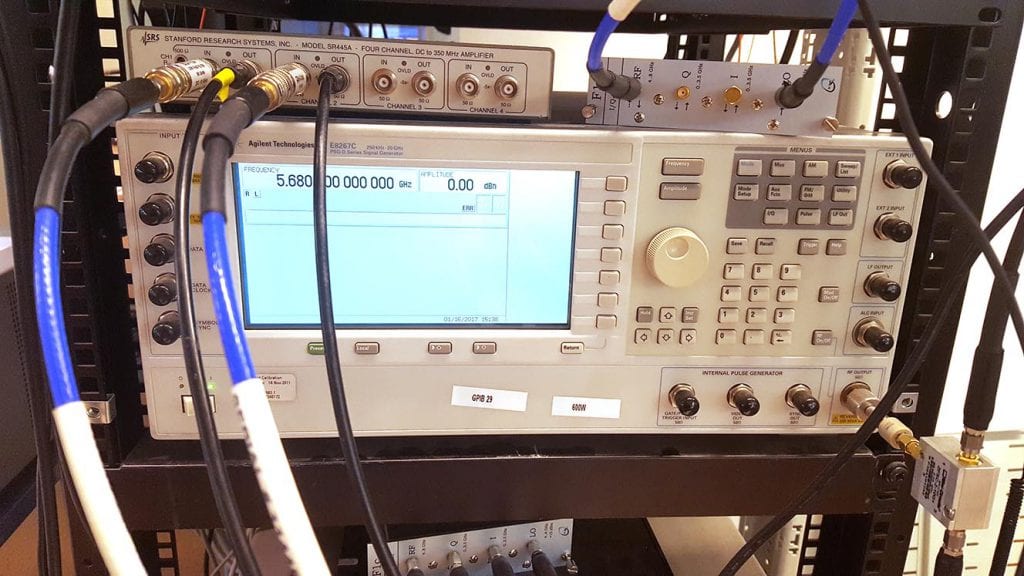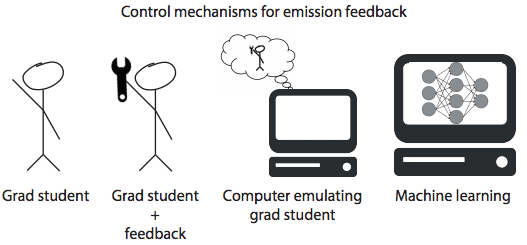27.01.2017difficulty level - Q
My Quantum Kitchenette

by James Kroll
There are many things that might pop in to your mind when I propose that you may be able to do quantum mechanics in the comfort of your own home. A ‘quantum kitchenette’ is probably not one of them.
This may have been a bit facetious, but it is true that many of the things you find in your kitchen such as a fridge, a microwave and beer bottles are perfectly analogous to the tools that are used in labs around the world to perform cutting edge experiments in quantum mechanics – in particular with applications in quantum computing.
These tools are technically challenging to fully understand, very expensive and equally impressive in their capabilities. As an experimental physicist, one of the most enjoyable parts of the job is using this equipment, understanding fully how it works so we can use and repair it if need be, but also the small idiosyncrasies that each specific piece of equipment acquires over time.
On a personal level, you really do develop an intimate relationship with your equipment, such that in some cases you are the only one who can use it reliably. A shorter way to summarise the connection might be: “Boys and their toys”, or whatever phrase would convey the same meaning in a more egalitarian manner.
The Fridge
The largest, most expensive and probably the most impressive piece of equipment we use on a daily basis is our ‘fridge’. And calling it a fridge doesn’t do it justice. Although the principle of operation is similar to that of the fridge that you have in your home, our fridges are colder. Much, much colder. The fridge I manage can go as cold as a temperature of 15 mK (-273.1 °C), which is so cold it almost stops the motion of atoms entirely. This is 20 times colder than outer space!
One of the amazing things about our current level of cryogenic technology is that we can realistically say that the coldest place in the universe is probably in one of the fridges that are used in cryogenics laboratories around the world. Astrophysical objects are generally more impressive than mankind in almost every other physical unit: they have more energy, weigh more, have lower vacuums or higher speeds – but in this corner of the universe we think we have them beat. And that is kind of neat.
To do this, turbomolecular vacuum pumps (basically small jet engines) are used to completely remove the air from the inner portions of the fridge, so that the cold bits don’t have any thermal contact with the not cold bits. This vacuum is roughly comparable to the atmospheric pressure at 200km, that’s half way to the ISS!

Here we have the lovely Damaz, modelling the cutting edge in current cryogenic technology. In the foreground, you can also see multiple turbomolecular pumps we were using to analyse an internal gas leak.
The reason we go to such great lengths to get things cold is the experiments we do require it. Our experiments invariably aim to study quantum mechanics, and most quantum mechanical systems are incredibly sensitive to their environment. Warm or noisy environments can easily wash out the delicate electronic signals that we look for when we want to study the physical world.
The Microwave
Whilst most people know about microwaves purely as a way to heat their 3 day old pasta (or in rare cases measure the speed of light using a chocolate bar), the reason they are called microwaves are because they use electromagnetic radiation in the ‘microwave’ region of the spectrum. As the name suggests, these are waves of light that are quite ‘small’ in size, ranging from 0.1cm to 100cm, so really they should be called ‘centiwaves’.
It is also a region of the electromagnetic spectrum reserved for telecommunications purposes, specifically mobile phones and WiFi (interesting aside, WiFi doesn’t actually stand for anything). Originally they were investigated for use in radar and subsequently satellite communication and GPS.
This may sound irrelevant, but the historical military use and current use in communications means that a lot of money has been invested in developing microwave technology so that we can have (relatively) cheap, incredibly precise microwave equipment that easily interfaces with other components.
Why do we care about this? Well, the quantum devices I work with are addressable and controllable with microwaves. By changing the frequency, sending the waves in pulses of different lengths and amplitudes we can prepare, manipulate and readout our qubits.
This is a particularly big deal when you consider that experimental physics in other fields, whilst impressive, can amount to hobbling together disparate components to get the effect you want. It will usually work, but it won’t work well and it certainly won’t be pretty.
We, on the other hand, get to reap the benefits of 50 years of microwave technology development to give us precise control over our qubits (a qubit is our quantum generalisation of a computer ‘bit’ that allows us to do information processing).

It may not look like much, but this is about as complex as consumer technology can get and still work reliably. No, you can’t use it to microwave your burrito. Yes, I’m sure someone has tried.
When I think about the fact that 4 or 5 pieces of equipment talk to each other 10 million times a second, can generate pulses as short as a thousand millionth of a second and repeat my experiment 50,000 times a second, I can’t help but be a little bit awe struck.
The Beer Bottle
This final piece is close to my heart, both as a Scot and as a quantum computing student. The heart of my research focusses on qubits, mostly trying to improve a certain kind of qubit based on superconducting circuits and make it play nicely with large magnetic fields, two things most physicists would consider to be in diametric opposition.
The coolest thing about my system though, is that it in some ways is perfectly analogous to a beer bottle. Have you ever blown on the top of a beer bottle? If you have, you’ll know that it resonates at a tone of a specific frequency, with the pitch of the frequency set by the size of the cavity where the pressure oscillations occur – if you fill the beer bottle with water, the tone will increase slightly, since the cavity has decreased in size. As you can see in the animation below, the magnitude of the pressure oscillations is greatest at the top of the bottle with almost no movement at the base of the bottle. This is due to the boundary condition that the air encounters the glass base, it cannot flex the strong glass so it is unable to move.

Using the finest in Dutch beer technology, I can now perfectly explain my experiment to the layman in a pub!
Now imagine that instead of creating an oscillation in a beer bottle with sound waves, we can create an oscillation in a small superconducting circuit, this time with microwaves! It works exactly the same as the beer bottle. The magical thing about these resonators is that because we have made them out of a superconductor, they are almost entirely lossless. A wave will bounce around in one of these resonators more than 100,000 times before eventually stopping. You can compare this to dropping a bouncing ball and watching it rebound from the floor. If you saw it do this 100,000 times before stopping, you would be quite impressed!
The quantum physics comes in when we couple this resonator to one of our qubits. Without going into the details, the frequency (tone) of our resonator changes very slightly, depending on the state of our qubit. By using the microwave sources described earlier, we prepare and manipulate our qubits, and then read them out by measuring the frequency of a resonator. By coupling many of these qubits together and allowing them to talk to each other, we can coax them into doing something useful for us, like factoring a prime number. It is hoped that in the near future, we might be able to turn these devices to work on other problems that are much more important for humanity like designing new medicines or materials; possibly even reducing the world’s energy usage by finding more efficient industrial catalysts. We may even be able to build an AI that can solve all these problems for us!
For now though, I’ll continue playing with my quantum kitchenette, trying to contribute what I can to the ongoing effort to build a quantum computer.
 James Kroll – I am James, an experimental physicist hailing from Scotland. I work in the topological quantum computing roadmap of Leo Kouwenhoven, as it requires an exciting mix of condensed matter physics theory, experimental cryogenics, electrical engineering and computer programming – all things that I somehow enjoy. If I’m not in the lab, you will most likely find me cycling somewhere or reading. Or eating. That’s a pretty important part of my life.
James Kroll – I am James, an experimental physicist hailing from Scotland. I work in the topological quantum computing roadmap of Leo Kouwenhoven, as it requires an exciting mix of condensed matter physics theory, experimental cryogenics, electrical engineering and computer programming – all things that I somehow enjoy. If I’m not in the lab, you will most likely find me cycling somewhere or reading. Or eating. That’s a pretty important part of my life.

